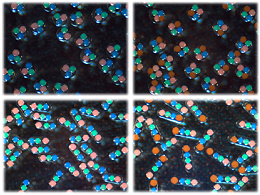マイクロ流体工学を利用して作製した多機能フォトニック結晶バーコード
Multifunctional photonic crystal barcodes from microfluidics
2012年9月7日 NPG Asia Materials 4, e9 (2012) doi:10.1038/am.2012.46
フォトニクス:色とりどりのバーコード

生体系は、さまざまな実験パラメーターを系統的に変化させるアッセイ法によって調べられることが多い。そうした方法の1つに、いわゆるバーコード粒子を用いてさまざまなサンプルを追跡する方法があるが、これは十分な数の構成を持つバーコードシステムを作製することが困難なため、厄介な方法と言える。今回、東南大学(中国、南京)のZhongze Guをはじめとする研究チームは、フォトニック結晶系バーコードシステムを開発した。これらのフォトニック結晶は、マイクロ流体システムを利用して作製され、作製時にフォトニック結晶の色反射を調節することが可能だ。また、バーコード粒子は磁性標識成分を含んでおり、磁場中で動くため読み出しが容易であるうえ、バーコードを覆うシェル部分にプローブ分子を固定化することもできる。1つのユニットの中で複数種のフォトニック結晶を組み合わせることによって、最高128万通りのマーカーが実現可能になる。
Photonics: Colorful barcodes
Biological systems are often studied through the use of assays, in which different experimental parameters are varied systematically. One method uses so-called barcode particles to track different samples. However this approach is complicated by the difficulty of producing barcode systems that allow for a sufficient number of configurations. Zhongze Gu and colleagues from Southeast University in Nanjing, China, have now developed a barcode system based on photonic crystals. These crystals, whose color reflection can be controlled during fabrication, are prepared with the help of a microfluidic system that also enables the simultaneous incorporation of the biomolecules to be probed. The barcodes particles also contain a magnetic tagged component that allows them to be moved in a magnetic field for easier read-out. By combining several types of photonic crystals in one unit, up to 1.28 million marker combinations are possible.

